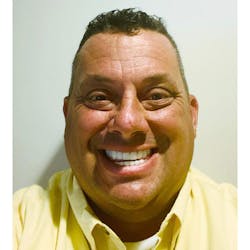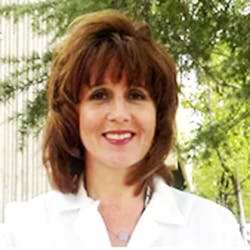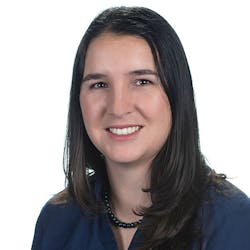Environmental Services (EVS) teams in healthcare organizations play an increasingly important role in infection control. They must protect patients and staff from Healthcare-Associated Infections (HAIs) within a reasonable turnover time and with a declining workforce.
Healthcare Purchasing News asked industry professionals to bring to light some of these everyday challenges EVS workers face and comment on some of the products and resources that allow them to efficiently disinfect the healthcare environment.
Keeping your surface disinfecting options open
The challenges currently being faced by EVS teams in healthcare facilities mirror a struggle felt industry-wide, according to Jaimee Rosenthal, Healthcare Markets Director, GOJO Industries. “How can they complete the critical tasks required in healthcare settings with a shrinking labor pool? EVS teams face the daunting challenge of keeping both public and patient care spaces free of illness-causing germs with fewer resources and a dizzying array of product options to choose from. Product manufacturers can help by bringing healthcare facilities options that allow EVS teams to work more efficiently and effectively.”
She emphasized, “Achieving a high sustainability rating or profile on surface disinfection products often comes at the expense of something else – typically either efficacy, safety rating, surface compatibility… or a mix of all of these. In today’s world, it is more important than ever to provide options that are as SAFE as they are EFFECTIVE to help minimize healthcare’s impact on the environment and the people in it.”
GOJO recently launched its new surface disinfecting wipes portfolio, which achieve a Category IV EPA safety profile rating and are FDA Food Code Compliant. They are ethyl alcohol-based and kill 99.9% of bacteria and viruses including the ESKAPE pathogens, COVID-19 and drug-resistant bacteria in under two minutes, according to company literature.1
“From an Environmental Protection Agency (EPA) perspective, products that achieve a Category IV rating represent those with the lowest toxicity rating and, correspondingly, the highest safety profile a product can achieve. But it’s also important to understand a product’s impact on the user (“Do I have to now wipe this surface down in case a patient’s food might come into contact with it?”) and to the surface being disinfected (“Will this damage or degrade my equipment?”),” said Rosenthal.
Healthcare facilities have long realized the critical role surface disinfection plays in their infection prevention programs, she continued. “With the industry experiencing extensive labor shortages, wipes are an essential tool in your cleaning arsenal.”
Doe Kley, BS, RN, CIC, MPH, T-CHEST, Senior Infection Preventionist, Clorox Healthcare said, “While it is an important time to reassess the protocols in place, a sanitary environment is key to infection prevention and control efforts. Healthcare facilities still need continued diligence as it relates to cleaning and disinfection given it plays an imperative role as part of a holistic strategy to help keep patients, visitors, and staff healthy and safe from other pathogens that are easily transmitted via surfaces.”
Healthcare facilities have and will continue to be challenged with preventing the spread of pathogens that contribute to healthcare-associated infections (HAIs) like Clostridioides difficile(C. diff), especially with the rise of antibiotic resistant pathogens, such as drug-resistant Candida auris (C. auris), Kley continued. “Both C. diff and C. auris can survive on surfaces for prolonged periods and frequent routes of transmission include contact with contaminated environmental surfaces such as medical equipment, fomites and person-to-person. Moving forward, it is also important for everyone in healthcare to continue playing a role in cleaning and disinfecting.”
Everyone should contribute to infection prevention efforts, Kley said. “While EVS are required to clean given areas once a day, all staff such as nurses should clean and disinfect their workspaces including high-touch surfaces such as telephones and printer control panels. Nurses should also wipe-down high-touch surfaces in patient rooms such as doorknobs, bed rails, bed tables and control panels of medical equipment at least once per shift. All clinical staff should also clean and disinfect any patient care equipment they are responsible for after each use. To do so effectively, it is important to ensure everyone uses the right product for the right occasion as different areas in a hospital may have different cleaning and disinfecting needs based on the location and transmission risks. Given the high traffic in hospitals, a sanitary environment is key to infection prevention and control efforts and to achieve this, it will mean continued collaboration among disciplines, IPs, and EVS professionals.”
Hygiene going digital
The COVID-19 pandemic emphasized the importance of ensuring proper hygiene compliance to help prevent the spread of illness, and evidence suggests that these heightened hygiene expectations are here to stay, according to Raquel Carbonari, North America Regional Brand Activation Director at Tork, an Essity Brand.
“Securing proper training for healthcare practitioners and EVS professionals can help departments deal with high rates of turnover,” she said. Tork designed Tork Clean Hands Training and Tork Clean Hospital Training with the goal in mind to make hand hygiene and cleaning environmental surfaces training more efficient, engaging and accessible at no cost.
“Virtual trainings allow for best practice sharing anytime, therefore contributing to better patient health outcomes,” Carbonari emphasized. Tork’s trainings utilize virtual reality (VR) to enhance results. Trainees can practice the World Health Organization’s (WHO) 5 moments for hand hygiene using their own hands.
Digital tools help EVS teams understand when and where there are cleaning needs in a facility, Carbonari said. “So many of our processes today have become digitized. Think back to 20 years ago, would it seem possible that patients would be filling out paperwork or checking into appointments on their mobile devices? Not only does digitalization make these processes much faster, but it supplies a steady stream of data from which healthcare professionals like IP technicians can make informed decisions.”
While not ‘new,’ automated hand hygiene monitoring systems, like the PURELL SMARTLINK technologies, are becoming more readily accepted said Rosenthal, GOJO. The SMARTLINK Activity Monitoring System provides data collection in facilities 24/7. The system informs hospitals of their hand hygiene performance so they can take action as needed.
“As healthcare facilities are renewing focus on basic patient safety and public health efforts like hand hygiene, ensuring that the right products are in the right places is important. Hand sanitizers and soaps that are efficacious, proven to maintain skin health and are preferred by healthcare workers are needed to support compliance-building efforts. Simply put, if healthcare workers don’t like the products, they won’t use them – and then what’s the point? PURELL offers a healthcare hand sanitizer that is efficacious at the lowest dose. This helps busy healthcare workers move between tasks more quickly, which is critical,” Rosenthal said.
Her colleague, Megan DiGiorgio, MSN, RN, CIC, FAPIC, Senior Clinical Manager, GOJO, expressed that quality improvement initiatives were placed on hold during the pandemic. “It’s still probably unclear the extent to which patient safety and quality have suffered. Be that as it may, quality metrics like hand hygiene are essential during times of both stability and crisis.”
The goal of any quality metric is to obtain reliable data to improve patient safety, yet hospitals relying on direct observation of hand hygiene alone are likely insufficiently allocating and deploying valuable resources, DiGiorgio continued. “The challenges of direct observation have been described at length, including capturing only a small portion of hand hygiene opportunities and the Hawthorne effect. Quality, safety and infection prevention leaders all readily acknowledge that a gap exists between reported compliance rates and hand hygiene behaviors taking place on a 24/7 basis and are questioning whether this gold standard is sufficient to manage risk in the wake of the growing burden of healthcare-associated infections (HAIs).”
Need to vent
Emerging pathogens and pandemics have expanded infection prevention and control program responsibilities requiring additional preparedness efforts and implementation strategies as recommendations have continuously evolved, according to Karen Hoffmann RN, MS, CIC, FAPIC, FSHEA, an infection preventionist consultant for the Vidashield UV24 from Nuvo Surgical. “The COVID-19 pandemic created a demand particularly surrounding products that could decrease aerosol exposure by increasing ventilation as droplet aerosol was recognized as the primary route of transmission.”
The COVID-19 pandemic has affected IPC programs as efforts were diverted to focus on pandemic management, she continued. “MRSA and central line-associated bloodstream HAI incidence significantly increased during the pandemic, while other HAIs remained relatively stable. Air contamination is now being recognized as a significant risk for cross-transmission. Current HVAC systems do not adequately address the aerosol route of transmission. Installing upper room germicidal ultraviolet irradiation (UVGI) for example the Vidashield UV 24 system that are an HVAC adjunct to provide continuous improved ventilation is an overdue need.”
COVID-19 exposed the weakness in infection prevention and control pandemic preparedness and stimulated many environmental solutions, Hoffmann emphasized. “The emergence of respiratory diseases, i.e., severe acute respiratory syndrome (SARS) epidemic in 2003, H1N1 influenza epidemic in 2011, and COVID-19 in 2020 has cemented the significance of providing adequate ventilation in healthcare facilities. There are three recommended environmental control measures fans, room air HVAC units and upper room ultraviolet germicidal irradiation (UVGI) to improve ventilation.”
The cheapest intervention is using fans with outside air which in healthcare is problematic because of a lack of filtration, she continued. “Room HEPA units with are economical but have several limitations including, being noisy so are often turned off or blocked, and since these units generally sit on the floor or are mounted to wall draw air in a directional airflow that can increase exposure and may likely do little to improve air exchange rates. UVGI, for example the Vidashield UV24 system has overcome these problems by pulling air directionally up to the ceiling and returning 99.7% purification. Initial installation costs of UVGI are higher than fans and most room HEPA units, but as an HVAC adjunct provides continuous 24/7 air filtration.”
Preparation matters
Another positive that came out of the pandemic was the creation of the Environmental Protection Agency (EPA) Emerging Viral Pathogens Program (EVP), said Sharon Ward-Fore, BS, MS, MT(ASCP), CIC, FAPIC, Metrex. “The emerging viral pathogen claim allows disinfectant companies to make claims against harder-to-kill pathogens in the event of an outbreak. Companies can apply for this claim before an outbreak occurs using previous EPA-approved kill claims. When the emerging viral pathogen guidance is triggered, the disinfectants approved by the EPA for this claim are then able to make off-label claims for the new pathogen responsible for the outbreak. The emerging viral pathogen claim helps us know which disinfectants will work against new pathogens in a timely manner without being delayed by needing to obtain and test the outbreak strain. This is how we prepare for the next pandemic.”
References:
1. GOJO. PURELL Brand Expands Surface Portfolio with Launch of Healthcare Surface Disinfecting Wipes. https://www.gojo.com/en/Newsroom/Press-Releases/2022/PURELL-Brand-Expands-Surface-Portfolio-with-Launch-of-Healthcare-Surface-Disinfecting-Wipes. Accessed June 1, 2022.
EVS Resource Guide Listings
Join the EVS Forum

Erin Brady | Assistant Editor
Erin Brady is Assistant Editor for Healthcare Purchasing News, an Endeavor Business Media publication.














